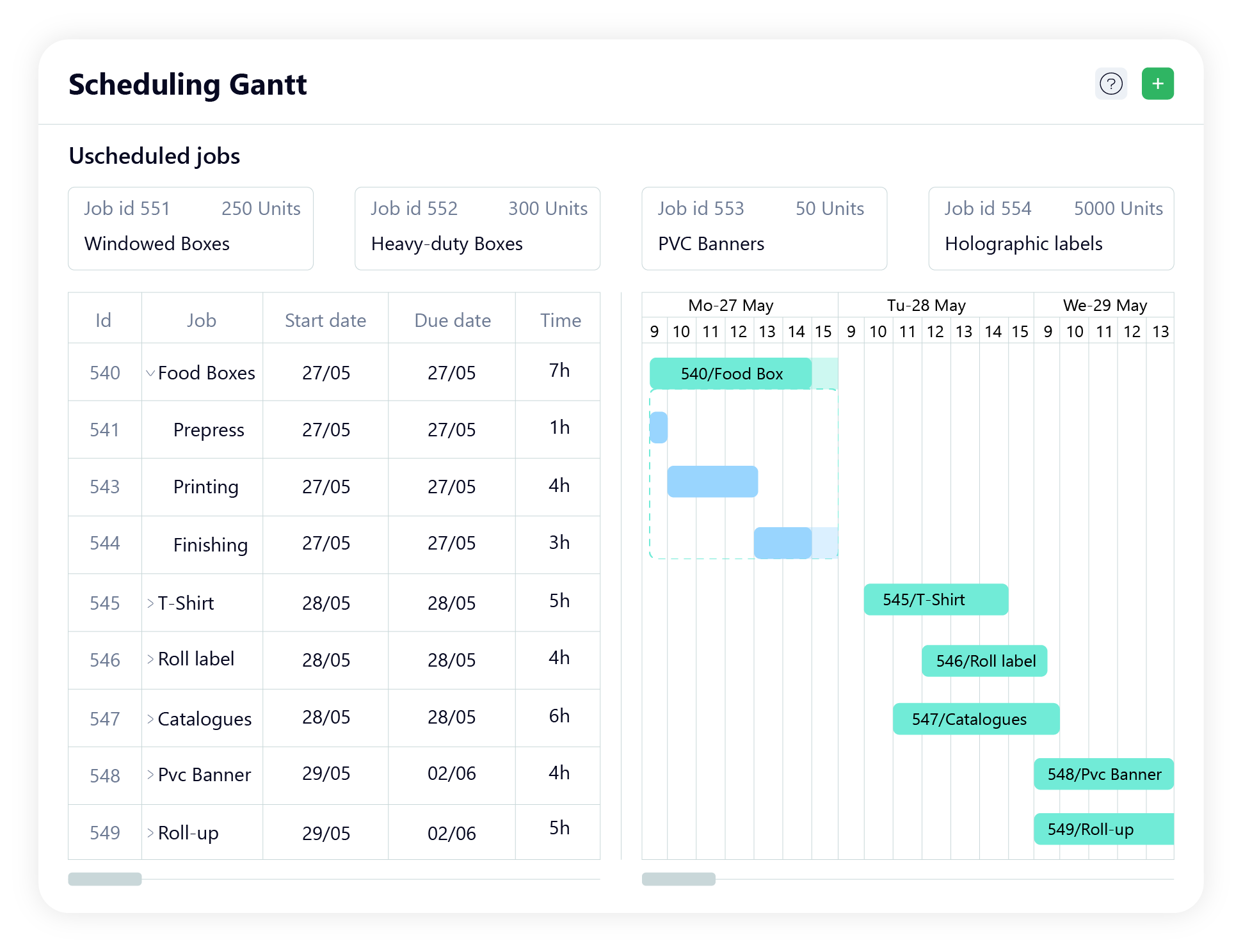Why Your Printing and Packaging Business Needs Smart Scheduling
Smart Scheduling: Optimize Time and Resources
Introduction
In the printing and packaging sector, resource scheduling is a daily challenge: urgent jobs, shared machinery, tight deadlines, and continual changes in job types make scheduling one of the most critical phases of the entire production flow.
Wsc Printer addresses these complexities with advanced tools that allow for dynamic and visual organization of each production phase.
Smart scheduling is not just a technical function: it is a strategic element that directly impacts profitability, delivery punctuality, and efficient use of company resources.

Performance in Numbers: Before and After Automation
- 📉 35% reduction in delays: thanks to proactive notifications and smart alerts that inform in real-time about blocks, changes, and unforeseen events.
- 📈 +40% punctuality in deliveries: by improving resource and flow management, deadlines are more easily met, increasing the reliability perceived by customers.
- ⚙️ +25% in machine usage: thanks to real-time visibility of availability and optimized activity allocation, even unproductive hours are drastically reduced.
- 📅 Complete daily, weekly, and monthly plan: planning is not limited to the short term but allows for a strategic and operational vision, useful for balancing loads, planning vacations, purchases, and maintenance.
- 🚀 +30% production capacity without new machinery: by optimizing sequences and minimizing downtime, what is already owned is better utilized, without the need to invest in new lines or equipment.
- 🔁 -50% in manual reprogramming: program changes no longer involve phone calls, emails, and meetings, but are managed with a click and automatically notified to all involved departments.
- 🤝 +20% efficiency between technical offices and production: thanks to data synchronization and shared visibility, communications become faster, more precise, and traceable.
- 🔊 -65% communication errors: changes to priorities and orders are recorded and disseminated in real-time, avoiding misunderstandings, double processing, or errors.
- 📂 100% historical traceability: every scheduling change is recorded. This is essential for post-job analysis, audits, continuous improvement, and accountability verification.
Why Your Company Needs It
- Visual planning with integrated Gantt: facilitates the understanding of the entire production line and offers a strategic and operational view.
- Centralized management of all departments: eliminates information silos and improves multi-plant coordination.
- Dynamic reprogramming: useful for urgent jobs or sudden changes by the client, with what-if simulations.
- Integration with the control room and warehouse: synchronizes production and material availability, improving internal logistics.
- Drastic reduction of human errors: less verbal communication, more automatic and digital control.
- Simulation of alternative scenarios: you can compare different sequences to choose the most efficient one.
- Workload forecasting: useful for balancing production and planning for potential bottlenecks in advance.
- Traceability and history of decisions: every action is recorded and available for audits or analysis.
- Reduction of decision-making time: centralized data access allows for quicker responses to changes.
Operational and Financial Damage without Automation
According to internal research, companies without an automated scheduling system can lose up to 18% of the annual production value. This loss stems from:
- Chronic delivery delays that generate penalties or service failures.
- Resource inefficiency with machine downtime and inactivity.
- Errors in managing priorities and urgencies.
- Hidden costs from manual replanning, unexpected overtime, and human errors.
- Drop in customer satisfaction and loss of strategic contracts.
- Difficulty in responding quickly to unforeseen events (machine breakdowns, missing materials).
On average, each poorly managed hour in planning can cost up to €300 between direct and indirect inefficiencies. Annually, this translates into tens or hundreds of thousands of euros that are irrecoverable.
The Smart Answer for Your Production Flow
Wsc Printer integrates intelligent planning tools capable of dynamically adapting to changes in load and urgency. Real-time visibility and the ability to simulate alternative scenarios make scheduling not just reactive but proactive. Operators work more calmly, production managers have total control, and customers receive what they expect more quickly.
The 10 Most Common FAQs About Print & Pack Scheduling
- How can I clearly view the entire production plan?
- Through integrated Gantt charts, which graphically represent the processing phases for each order, making the sequence and duration of activities evident. You can filter by department, job type, or priority and get an immediate overview of resource saturation.
- Can I modify the scheduling in real-time?
- Yes, you can move jobs, change priorities, or reassign resources with simple drag & drop operations, with immediate updates across all involved departments. The system maintains a detailed log of every change.
- Is it possible to integrate scheduling with the logistics department?
- Certainly. Information on scheduled orders can be automatically shared with logistics and the warehouse to prepare materials on time, ensuring smooth and uninterrupted production.
- Do operators receive automatic notifications about schedule changes?
- Yes, the system sends real-time notifications (email, dashboard, terminal alerts) to involved operators when the sequence or timing changes. Additionally, they can view their personal workload in real-time.
- Can multiple production departments be managed simultaneously?
- Wsc Printer supports multi-department and multi-plant environments, allowing you to view and control overall production capacity in a single view while keeping operational logics and priorities separate.
- Is there an alert system for delays or anomalies?
- Yes, thresholds and conditions can be set to receive automatic alerts on delays, machinery overloads, or missed assignments. Alerts can also be linked to internal KPIs.
- Can I create multiple scheduling scenarios to compare alternatives?
- Yes, Wsc Printer allows you to save alternative versions of the schedule to test and compare different production scenarios before finally activating them.
- How is resource saturation managed in case of sudden peaks?
- The system automatically analyzes the overall load and signals overloads, suggesting automatic reassignments or indicating available slots on other compatible machines.
- Is it possible to have visibility on machine performance and downtime?
- Absolutely. Each machine has an integrated KPI panel with hours worked, machine stops, and usage rate compared to capacity.
- Can the system help me balance urgent orders with planned ones?
- Yes, thanks to priority rules and the decision-making engine, you can insert new urgent orders and see the impact on the entire production in real-time, assessing whether to reorganize or maintain the current plan.
Conclusion
Implementing an intelligent scheduling system like Wsc Printer is essential for any company in the printing and packaging sector that wishes to optimize its operations. Benefits include increased efficiency, better resource management, and reduced operational costs. The ability to respond quickly to the continuously changing market needs and to anticipate future necessities makes this tool an indispensable investment for long-term success.

Get weekly updates
in your inbox!




